Related Research Articles

Chicano or Chicana is a chosen identity for many Mexican Americans in the United States. The label Chicano is sometimes used interchangeably with Mexican American, although the terms have different meanings. While Mexican American identity emerged to encourage assimilation into White American society and separate the community from African-American political struggle, Chicano identity emerged among anti-assimilationist youth, some of whom belonged to the Pachuco subculture, who claimed the term. Chicano was widely reclaimed in the 1960s and 1970s to express political empowerment, ethnic solidarity, and pride in being of Indigenous descent, diverging from the more assimilationist Mexican American identity. Chicano Movement leaders were influenced by and collaborated with Black Power leaders and activists. Chicano youth in barrios rejected cultural assimilation into whiteness and embraced their identity and worldview as a form of empowerment and resistance.
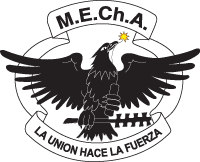
M.E.Ch.A. is a US-based organization that seeks to promote Chicano unity and empowerment through political action. The acronym of the organization's name is the Chicano word mecha, which is the Chicano pronunciation of the English word match and therefore symbolic of a fire or spark; mecha in Spanish means fuse or wick. The motto of MEChA is 'La Union Hace La Fuerza'.
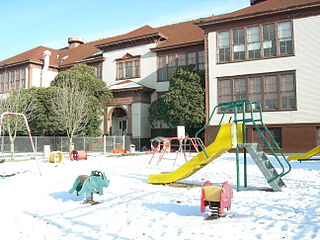
El Centro de la Raza in Seattle, Washington, United States, is an educational, cultural, and social service agency, centered in the Latino/Chicano community and headquartered in the former Beacon Hill Elementary School on Seattle's Beacon Hill. It was founded in 1972 and continues to serve clients in Seattle, King County and beyond. It is considered a significant part of civil rights history in the Pacific Northwest.

The Brown Berets are a pro-Chicano organization that emerged during the Chicano Movement in the late 1960s co-founded by David Sanchez and Carlos Montes, and remains active to the present day. The group was seen as part of the Third World Liberation Front. The Brown Berets' movements largely revolved around farmworkers' struggles, educational reform, and opposition to the Vietnam War; they have also organized against police brutality. The Brown Berets have also sought to separate the American Southwest from the control of the U.S. government.
Chicanismo is the ideology behind the Chicano movement. It is an ideology based on a number of important factors that helped shape a social uprising in order to fight for the liberties of Mexican-Americans. Chicanismo was shaped by a number of intellectuals and influential activists as well as by the artistic and political sphere, and the many contributors to the ideology collaborated to create a strong sense of self-identity within the Chicano community. Cultural affirmation became one of the main methods of developing Chicanismo. This cultural affirmation was achieved by bringing a new sense of nationalism for Mexican-Americans, drawing ties to the long-forgotten history of Chicanos in lands that were very recently Mexican, and creating a symbolic connection to the ancestral ties of Mesoamerica and the Nahuatl language.
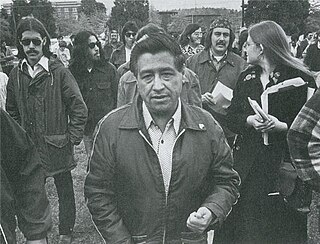
The Chicano Movement, also referred to as El Movimiento, was a social and political movement in the United States inspired by prior acts of resistance among people of Mexican descent, especially of Pachucos in the 1940s and 1950s, and the Black Power movement, that worked to embrace a Chicano/a identity and worldview that combated structural racism, encouraged cultural revitalization, and achieved community empowerment by rejecting assimilation. Before this, Chicano/a had been a term of derision, adopted by some Pachucos as an expression of defiance to Anglo-American society. With the rise of Chicanismo, Chicano/a became a reclaimed term in the 1960s and 1970s, used to express political autonomy, ethnic and cultural solidarity, and pride in being of Indigenous descent, diverging from the assimilationist Mexican-American identity.
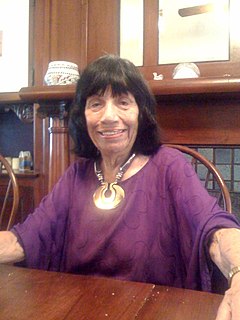
Elizabeth "Betita" Martínez was an American Chicana feminist and a long-time community organizer, activist, author, and educator. She wrote numerous books and articles on different topics relating to social movements in the Americas. Her best-known work is the bilingual 500 years of Chicano History in Pictures, which later formed the basis for the educational video ¡Viva la Causa! 500 Years of Chicano History. Her work was hailed by Angela Y. Davis as comprising "one of the most important living histories of progressive activism in the contemporary era ... [Martínez is] inimitable ... irrepressible ... indefatigable."
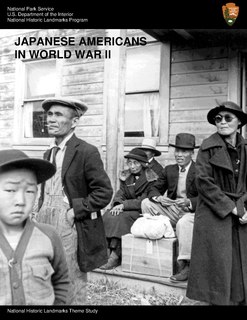
Densho is a nonprofit organization based in Seattle, Washington whose mission is “to preserve and share history of the WWII incarceration of Japanese Americans to promote equity and justice today.” Densho collects video oral histories, photos, documents, and other primary source materials regarding Japanese American history, with a focus on the incarceration of Japanese Americans during World War II. Densho offers a free digital archive of these primary sources, in addition to an online encyclopedia and curricula, for educational purposes.

Martha P. Cotera is a librarian, writer, and influential activist of both the Chicano Civil Rights Movement and the Chicana Feminist movement of the 1960s and 1970s. Her two most notable works are Diosa y Hembra: The History and Heritage of Chicanas in the U.S. and The Chicana Feminist. Cotera was one of six women featured in a documentary, Las Mujeres de la Caucus Chicana, which recounts the experiences of some of the Chicana participants of the 1977 National Women's Conference in Houston, Texas.
The Waterfront Workers History Project is a program of the University of Washington, which serves to document the history of workers and unions active on the ports, inland waterways, fisheries, canneries, and other waterfront industries of the western United States and Canada, specifically, California, Oregon, Washington, Alaska, and British Columbia. In collaboration with the Pacific Northwest Labor and Civil Rights History Projects, and sponsored by the Harry Bridges Center for Labor Studies, the Project is a collective effort to organize and present historical data covering significant events from 1894 to the current day.
The Great Depression in Washington State Project is a multimedia web resource based at the University of Washington in Seattle. Created in the context of renewed economic hard times in 2009, the Project includes essays, maps, digitized newspaper articles and hundreds of rare photographs from the 1930s. In addition to rapid industrialization and demographic change, the Depression ended decades of Republican rule, created a powerful labor movement, changed the face of the Democratic Party and molded new set of political priorities. In several thematic sections, the Project examines these changes in everyday life, culture, politics and work. The Project is one of the Pacific Northwest Labor and Civil Rights History Projects, characterized by student-led research and public scholarship.
The Seattle General Strike Project is a multimedia initiative to chronicle the Seattle General Strike, the first general strike in the United States. In February 1919, what began as a wage dispute in the city’s shipyard expanded into a week-long walkout involving more than 50,000 workers that heralded a wave of post-war labor unrest and America’s first red scare. The website maintained by the project is one of the foremost collections of primary and academic material on the event, and is part of the Pacific Northwest Labor and Civil Rights History Projects program at the University of Washington.
The Labor Press Project: Pacific Northwest Labor and Radical Newspapers is a multimedia website housing thousands of digitized articles and editions from the late 19th century to the present. Newspapers and newsletters from unions, early socialist groupings, anarchist communes, ethnic community groups and radical organization are presented on the site with accompanying research articles on their context and evolution. Many of the digitized materials were previously unavailable except as archival material. The extensive resource is one of Pacific Northwest Labor and Civil Rights History Projects developed by the University of Washington.
The Black Panther Party History and Memory Project is a multimedia effort to chronicle the Seattle chapter of the Black Panther Party. Founded in 1968, the Seattle Chapter was one of the first to be formed outside Oakland and became one of longest lived bases of the Party. The Project is the largest online collection of materials about any branch of the organization. The materials include detailed video oral histories, historical documents and photographs and the complete transcript of a 1970 Congressional Hearing held on the Seattle Chapter. The Project is an initiative of the Seattle Civil Rights and Labor History Project at the University of Washington.
The Pacific Northwest Labor and Civil Rights History Projects are a series of multimedia public history initiatives. The projects cover a range of themes and subjects in the Northwest and Seattle, with a particular focus on working people and their movements. The effort, particularly the Seattle Civil Rights and Labor History Project, has garnered praise for the breadth of primary and secondary resources made available and its joint creation by academics, community members and hundreds of students. It has been recognized as a model of digital and publicly engaged scholarship.
Strikes! Labor History Encyclopedia of the Pacific Northwest is a clearinghouse of information on the labor history of the region developed by the University of Washington and Professor James N. Gregory as part of the Pacific Northwest Labor and Civil Rights History Projects. The Encyclopedia covers the major industries of Washington state, major unions and worker struggles, civil rights activism among many ethnic communities, radical organizations, the Great Depression and the New Deal and the region's rich history of labor and radical newspapers.

Greater Seattle has had a Chinese American community almost since its founding in 1851. Chinese workers arriving in the 1860s were welcomed, because the Seattle area was sparsely settled and workers were needed; within a few decades, however, newly arrived white settlers resented the Chinese workers, and there were several anti-Chinese riots as the whites attempted to expel the Chinese from the area. Chinese settlement persisted, with the immigrants settling in a well-defined Chinatown where they maintained their culture through family groups, associations, and churches. In the mid-20th century Chinese Americans joined with other immigrant groups to oppose racial discrimination. In 1962 a Chinese American became the first person of Asian ancestry to hold elective office in the state of Washington.
Hijas de Cuauhtémoc was a student Chicana feminist newspaper founded in 1971 by Anna Nieto-Gómez and Adelaida Castillo while both were students at California State University, Long Beach.
Manuela Solís Sager (1912-1996) was a Mexican American labor leader, union organizer and educator. She is best known for her work organizing with Mexican women in Texas during the 1930s, where 40% of the total Mexican population were employed almost exclusively in low paid, low status jobs.

La Conferencia de Mujeres por la Raza was held in Houston, Texas between May 28 and May 30 in 1971. The conference marked the first time Mexican-American feminists came together within the state from around the country to discuss issues important to feminism and Chicana women. It was considered the first conference of its kind by the Corpus Christi Caller-Times.
References
- ↑ Gregory, James; Trevor Griffey (April 2007). "Teaching a City about Its Civil Rights History: A Public History Success Story". Perspectives. 45 (4).
- ↑ Griffey, Trevor (January 2012). "Rethinking Race and Place: The Seattle Civil Rights and Labor History Project". OAH Magazine of History. 26 (1): 47–50. doi:10.1093/oahmag/oar049.
- ↑ Gregory, James; Trevor Griffey (Spring 2007). "Seattle Civil Rights & Labor History Project: an Online Video Oral History Collection" (PDF). Northwest Oral History Association Newsletter.
- ↑ Turnbull, Lornet (June 3, 2005). "Homeowners find records still hold blot of racism". Seattle Times.
- ↑ Gregory, James (April 6, 2006). "Stain of racism still haunts Seattle neighborhoods". Seattle Times.
- ↑ Rosales-Castaneda, Oscar (Spring 2012). "Writing Chicana/o History with the Seattle Civil Rights and Labor History Project". Writing History in the Digital Age.
- ↑ Gregory, James; Trevor Griffey (April 2007). "Teaching a City about Its Civil Rights History: A Public History Success Story". Perspectives. 45 (4).
- ↑ Gregory, James; Trevor Griffey (Spring 2007). "Seattle Civil Rights & Labor History Project: an Online Video Oral History Collection" (PDF). Northwest Oral History Association Newsletter.